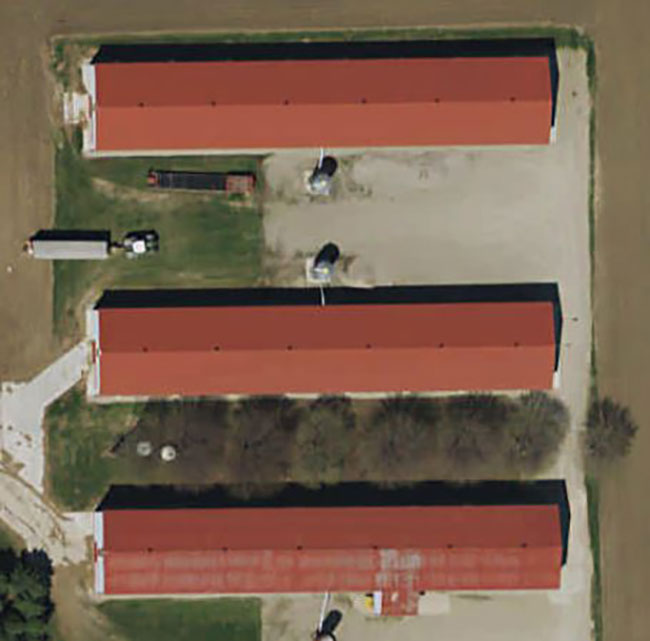
Features
Drainage Management Systems
Guest Column
Designing drainage long-term
Accounting for impermeable surfaces.
July 6, 2020 By Jacqui Empson Laporte
 If the barn downspouts are directed into the tile drainage system, this is a huge amount of water for the tile and municipal drainage system to absorb in a relatively short period of time. Photo courtesy of Google Earth/Jacqui Empson Laporte.
If the barn downspouts are directed into the tile drainage system, this is a huge amount of water for the tile and municipal drainage system to absorb in a relatively short period of time. Photo courtesy of Google Earth/Jacqui Empson Laporte. It often feels that society responds to challenges, rather than planning in advance. Drainage is no different. The majority of these quotations are going to the larger and more experienced construction companies.
Nevertheless, I am often called upon in mid-season (and during a snowstorm) to help “size” a particular job for temporary heat. It can be a challenge for the best of us.
I would expect that the majority of calls drainage contractors receive result from a customer seeing a problem such as erosion or ponding, and wanting it fixed. So, when I saw news reports of flooding in the U.S. and Canada this past fall, I thought about our drainage program and what challenges might be coming in the future.
A common theme in flooding events has been the increase in impermeable surfaces – pavement and concrete that prevent the water from soaking into the ground. The flooding in Toronto in August 2018, resulted from 2.95 inches or 75 millimeters (mm) of rain in downtown areas, and Black Creek rose 11.5 ft (3.5 meters) in 90 minutes. In June 2017, my area was hit with a one-in-100-year storm event, and received 6.7 inches (170 mm) of rain in seven hours.
So, what does this have to do with rural drainage? Plenty.
When we design municipal drainage systems, the engineer will account for the area requiring drainage and the land use. Is the land use primarily row crops or permanent pasture, or forested?
What they will rarely account for is impermeable surfaces in farmsteads. As farm buildings become larger, the volume of water that runs off the roof and paved areas also increases.
Adding to this overall change in farm construction are factors that lead to an increase in buildings and pavement. Farm safety in the poultry industry is a move from multi-story facilities to single story buildings, but more of them to house the same number of birds. Modernized animal welfare standards are increasing the number of square footage (ft2) per animal. Technology and efficiency in barn design are resulting in larger areas for traffic flow and transportation.
Let’s take this example.
There are three poultry barns, approximately 9800 ft2 per structure.
If we got two inches of rain in one storm event, that would equal 1633 foot cubed (ft<3) of water per structure, or 4899 ft3 from the roofs alone. Historically, this water would simply infiltrate the soil, or run off the farmstead into adjacent fields for infiltration.
If the barn downspouts are directed into the tile drainage system, this is a huge amount of water for the system to absorb in a relatively short period of time. The tile systems are going to discharge into a municipal drain. Even if the tile system can handle it, the receiving municipal drain or channel down the line must also be able to manage it. Even if they can hold the volume of water in open channel systems, they might not be able to handle the speed at which the water enters the system. This results in the high degree of fluctuation in water levels, similar to the Black Creek experience, where water levels rose and fell in quick succession. In addition, some of the storm events are happening during the winter period, when infiltration will be non-existent.
If those structures were in an urban area or even used for something other than agriculture, there would be a requirement for a stormwater management plan.
I am not suggesting that we should move in a regulatory site-specific direction, but rather consider unique opportunities in rural areas. Could we incorporate a rural cistern sort of system that would could be used for firefighting? Some building standards offer some relief from the requirement for fire walls if there is an onsite source of water. Insurance companies may also be interested in any structures that provided rural hydrants.
In Ontario, we don’t usually have a need for irrigation, but in future, maybe we will. Could this be an opportunity to see the collection of water as a benefit, instead of a cost? For farmers and tile contractors, the time to think about this is in the pre-construction period. For engineers and drainage superintendents, what impact will large impermeable surfaces have on municipal drain designs?
Jacqui Empson Laporte is an environmental specialist and a member of the drainage team for the Ontario Ministry of Agriculture, Food and Rural Affairs. You can find Jacqui on Twitter at @notrunningfast.
Print this page